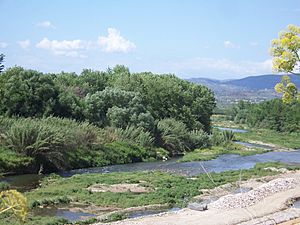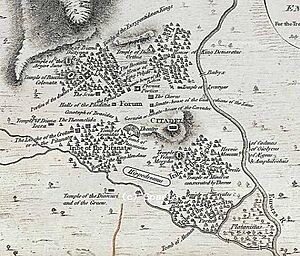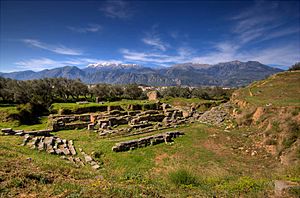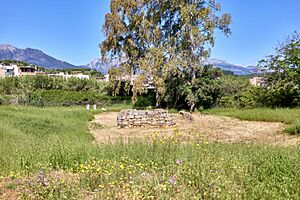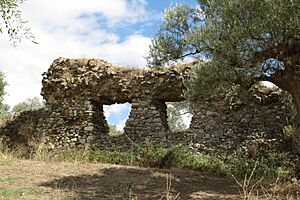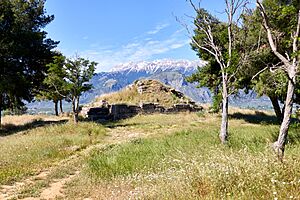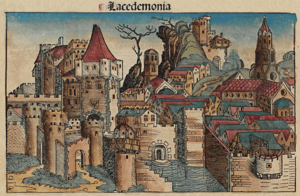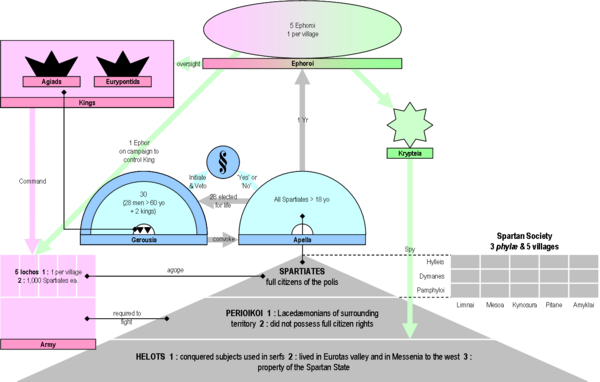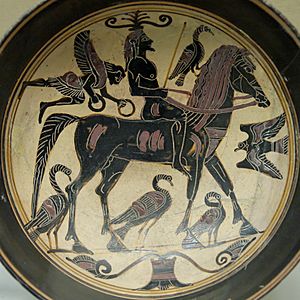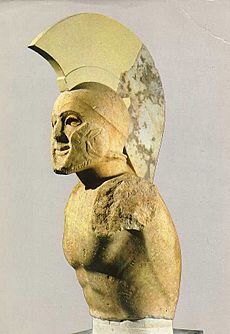Sparta facts for kids
Quick facts for kids
Sparta
Λακεδαίμων (Ancient Greek)
|
|||||||||||
|---|---|---|---|---|---|---|---|---|---|---|---|
| 900s–192 BC | |||||||||||
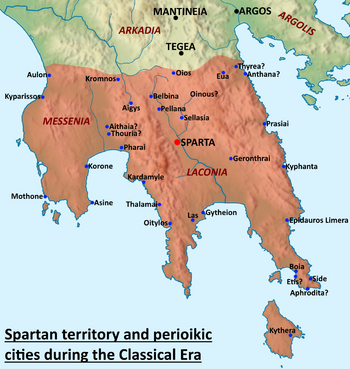
Territory of ancient Sparta before 371 BC, with Perioecic cities in blue
|
|||||||||||
| Capital | Sparta 37°4′55″N 22°25′25″E / 37.08194°N 22.42361°E |
||||||||||
| Common languages | Doric Greek | ||||||||||
| Religion | Greek polytheism | ||||||||||
| Government | Diarchic monarchy | ||||||||||
| King | |||||||||||
|
• c. 930–900 BC
|
Agis I | ||||||||||
| Legislature |
|
||||||||||
| Historical era | Classical antiquity | ||||||||||
| 900s BC | |||||||||||
|
• Messenian War
|
685–668 BC | ||||||||||
| 480 BC | |||||||||||
| 431–404 BC | |||||||||||
|
• Battle of Mantinea
|
362 BC | ||||||||||
| 192 BC | |||||||||||
|
|||||||||||
| This article contains special characters. Without proper rendering support, you may see question marks, boxes, or other symbols. |
Sparta was a powerful city-state in ancient Greece. It was located in a region called Laconia. People in ancient times also called the state Lacedaemon. "Sparta" was the name for its main city, a group of villages in the valley of the Evrotas River.
Around 650 BC, Sparta became one of the strongest military forces in Greece. It kept this status until 371 BC. Sparta led the Greek army during the Greco-Persian Wars, competing with Athens. Sparta was Athens' main enemy during the Peloponnesian War (431–404 BC). Sparta won this war after the Battle of Aegospotami.
Later, Thebes defeated Sparta at the Battle of Leuctra in 371 BC. This ended Sparta's dominance and freed Messenia. Losing Messenia meant losing many enslaved workers. This caused Sparta to decline as a military power. Sparta remained independent until 192 BC, when it joined the Achaean League.
After the Romans conquered Greece in 146 BC, Sparta regained some freedom. It became a popular place for Roman tourists. This brought back some wealth. However, in 396 AD, the Visigoths attacked Sparta. The city then declined through the medieval period. Many people moved to Mystras. Today, modern Sparta is a town and the capital of the Laconia region.
Sparta was special in ancient Greece because of its social system and laws. These were supposedly created by a legendary lawgiver named Lycurgus. Spartan society focused heavily on military training. Citizens called Spartiates spent all their time on physical and military development. They were not allowed to do regular jobs.
Spartan society had strict levels. There were Spartiates (full citizens), perioikoi (free non-citizens), and helots (enslaved people). Helots made up most of the population. Spartiate men went through a tough training program called the agoge. Spartan phalanx soldiers were known as excellent fighters. Free Spartiate women had more rights than women elsewhere in ancient times. However, helots were treated very harshly. This led to many revolts. People in ancient times and later admired Sparta. This admiration is called Laconophilia.
Contents
- Understanding Spartan Names
- Sparta's Location and Natural Defenses
- Myths and Legends of Sparta
- Exploring Ancient Sparta Through Archaeology
- A Look at Sparta's History
- How Classical Spartan Society Was Organized
- Daily Life in Classical Sparta
- The Important Role of Women in Sparta
- Admiration for Sparta: Laconophilia
- Notable Ancient Spartans
- Images for kids
- See also
Understanding Spartan Names
The ancient Greeks used a few words for Sparta. "Sparta" usually meant the main group of villages in the Eurotas River valley. The word "Lacedaemon" (Λακεδαίμων) was often used to describe the state. Historians like Herodotus and Thucydides used this name. "Laconice" (Λακωνική) referred to the area around Sparta. Sometimes it meant all the lands Sparta controlled.
The people of Sparta were often called Lacedaemonians. This name came from "Lacedaemon." Sometimes, the land itself was called "Lacedaemonia." This term became more common during Roman times.
Sparta's Location and Natural Defenses
Sparta was in the region of Laconia, in the southeastern Peloponnese. It was built along the Eurotas, Laconia's largest river. This river gave them fresh water. The Eurotas valley was like a natural fort. To the west, it had Mount Taygetus (2,407 m). To the east, it had Mount Parnon (1,935 m).
Hilly lands to the north separated Laconia from Arcadia. These natural barriers helped protect Sparta from attacks. Even though Sparta was inland, it had a port city called Gytheio on the Laconian Gulf.
Myths and Legends of Sparta
Lacedaemon was a legendary king of Laconia. He was said to be the son of Zeus, the king of the gods. His mother was the nymph Taygete. Lacedaemon married Sparta, a daughter of the river god Eurotas. He named his country after himself and the city after his wife.
Ancient writers also connected Spartans to the hero Heracles. They believed Spartans were descendants of Heracles. This made them feel proud and strong.
Exploring Ancient Sparta Through Archaeology
The historian Thucydides once wrote that if Sparta were empty, people in the future might not believe how powerful it was. He said Sparta looked more like a group of villages than a grand city. It did not have many splendid buildings.
Until the early 1900s, not much of ancient Sparta was visible. There were parts of a theater and a building called the Tomb of Leonidas. This building was made of huge stone blocks. There were also ruins of a bridge and some Roman walls.
Archaeologists found many interesting items. These included inscriptions, sculptures, and other artifacts. The American School of Classical Studies at Athens and the British School at Athens began serious excavations. They uncovered more of the theater and a circular building.
In 1906, excavations in Sparta itself began. They found a theater-like building near the Temple of Artemis Orthia. This was where musical and athletic contests took place. It was also where Spartan boys faced a tough test of endurance. The temple itself was built on older temple foundations. Many small offerings were found there. These items tell us a lot about early Spartan art.
Archaeologists also found the location of the sanctuary of Athena. This was on the acropolis above the theater. They traced parts of the city wall, which was built over many years. This wall was about 10 kilometers long.
The Menelaion Shrine
The Menelaion is a shrine east of Sparta, near the Eurotas River. Spartans believed it was once the home of Menelaus. Around the early 8th century BC, a shrine was built here. In the 1970s, excavations found remains of two Mycenaean mansions. They also found offerings dedicated to Helen and Menelaus. These mansions were destroyed by natural disasters.
Recent excavations suggest this area was a center of Mycenaean Laconia. The Mycenaean settlement was large. However, most of its buildings are now ruined.
A Look at Sparta's History
Early Times and the Archaic Period
It's hard to know much about Sparta's earliest history. The oldest signs of human life in the area are pottery from the Middle Neolithic period. This pottery was found near Kouphovouno, close to modern Sparta.
Later, during the late Bronze Age, tribes from the north called Dorians arrived. They settled in the Peloponnese. The Dorians quickly expanded Spartan lands. They fought against other Greek groups. Sparta was naturally protected by mountains. This meant it was never fortified with walls in its early days.
Between the 8th and 7th centuries BC, Sparta faced problems. There was a time of disorder and conflict. To fix this, Spartans made big changes to their society and government. They believed these changes came from a legendary lawgiver named Lycurgus. Many ancient writers praised these "Lycurgan Reforms."
Sparta's Classical Era
After the Second Messenian War, Sparta became a major power in Greece. For centuries, its army was unmatched on land. Around 500 BC, Sparta had many citizens, plus many helots and perioikoi. This made it one of the largest Greek city-states.
In 480 BC, a small group of Greeks faced a huge Persian army at the Battle of Thermopylae. King Leonidas led about 300 Spartan soldiers. They fought bravely until the end. This battle became a legend. The Spartans had been warned by their former king, Demaratus. An oracle had said that either a Spartan king must die or Sparta would be destroyed. Leonidas's death fulfilled this prophecy.
The Greeks won a major victory against the Persians at the Battle of Plataea in 479 BC. Spartan soldiers, with their strong hoplite armor and phalanx fighting style, were key to this win. This victory ended the Greco-Persian War. It stopped Persia from expanding into Europe. Sparta received much credit for leading the Greek forces.
In 464 BC, a powerful earthquake hit Sparta. It destroyed much of the city. This event contributed to the start of the First Peloponnesian War.
Later, Sparta, Athens, Thebes, and Persia were the main powers in the Mediterranean. During the Peloponnesian War, Sparta built a navy. This navy defeated Athens' powerful fleet. This ended the Athenian Empire. At its strongest, in the early 4th century BC, Sparta controlled many Greek states. It even invaded Persian lands in modern-day Turkey. This time is known as the Spartan hegemony.
During the Corinthian War, Sparta fought against Athens, Thebes, Corinth, and Argos. Persia supported this alliance. Sparta won battles on land. However, its navy was badly damaged by a Persian-backed fleet. This weakened Sparta's sea power.
In 387 BC, the Peace of Antalcidas was signed. It gave Greek cities in Asia Minor back to Persia. This showed that Persia could still influence Greek politics. Sparta's power in Greece was also weakened. Sparta suffered a major defeat to Epaminondas of Thebes at the Battle of Leuctra.
Over time, the number of Spartan citizens decreased. The helot population grew much larger. This created tension in society.
Sparta in Hellenistic and Roman Times
Sparta never fully recovered after its defeat at Leuctra in 371 BC. It also faced many helot revolts. In 338 BC, Philip II invaded Laconia. He did not capture Sparta itself. When Philip created the League of Corinth, Sparta refused to join. They only wanted to lead such a group.
Later, Alexander the Great defeated the Persians. He sent armor to Athens with a message. It said, "Alexander, son of Philip, and all the Greeks except the Spartans, give these offerings." This showed Sparta's independent spirit.
Sparta continued to be a power in the Peloponnese. But it eventually lost its independence in 192 BC. Pyrrhus of Epirus tried to attack Sparta in 272 BC but failed. King Cleomenes III tried to make Sparta strong again. He was defeated in 222 BC. Sparta became an ally of the Roman Republic during the First Macedonian War.
Sparta lost its political freedom when it was forced into the Achaean League in 192 BC. This happened after its defeat in the Laconian War. Its last king, Nabis, was overthrown. Sparta did not play a big role in the Achaean War in 146 BC. After Rome conquered Greece, Sparta became a free city under Roman rule. Some of its old customs were brought back. It became a place where Roman tourists visited to see its unique traditions.
Spartans had long believed that city walls made men soft. They thought their warriors were enough protection. But after 184 BC, a wall was finally built around the city. This was after Sparta's greatest power had passed.
Sparta in Later Ages and Today
In 396 AD, the Visigoths led by Alaric I attacked Sparta. Some parts of the Laconia region kept their old beliefs until the 10th century. The Tsakonian language is still spoken in Tsakonia today. It is the only language left from ancient Doric Greek. In the Middle Ages, the important center of Laconia moved to Mystras. Sparta became less important.
Modern Sparta was re-established in 1834 by King Otto of Greece. Today, it is a regional town. It is the capital of the Laconia administrative area.
How Classical Spartan Society Was Organized
Sparta's Government: The Constitution
Sparta had a unique government system. It was an oligarchy, meaning a few people held power. The state was led by two hereditary kings. These kings came from two different families, the Agiad and Eurypontid families. They were believed to be descendants of Heracles. Both kings had equal power.
The kings mainly handled religious duties, legal matters, and military leadership. They were the chief priests and communicated with the Delphian sanctuary. Their legal duties became more limited over time. Aristotle described the Spartan kingship as "a kind of unlimited and perpetual generalship."
Other officials called ephors handled civil and criminal cases. There was also a council of elders called the Gerousia. This council had 28 elders, all over 60 years old. They were elected for life and included the two kings. The Gerousia discussed important state decisions. They would then suggest policies to the damos, which was the assembly of all Spartan citizens. The citizens would then vote on these ideas.
Over time, the kings' power decreased. The ephors took on more control, especially in foreign policy. The kings mostly served as generals. The real political power shifted to the ephors and the Gerousia. The Ekklesia, the assembly of citizens, elected members to the Gerousia for life.
Who Was a Spartan Citizen?
To be a full citizen in Sparta, boys had to complete the special training called the agoge. Usually, only boys whose families were original inhabitants of the city could join the agoge. These were the Spartiates.
There were a few exceptions. Trophimoi were foreign students invited to train in Sparta. For example, the Athenian general Xenophon sent his sons there. Also, a helot boy could become a syntrophos if a Spartiate adopted him and paid for his training. If he did very well, he might even become a Spartiate. Spartans who could not pay for the agoge could lose their citizenship.
These rules meant Sparta struggled to replace citizens lost in battles. The number of citizens became much smaller than the non-citizens and helots. This created problems for Sparta.
Non-Citizens in Sparta
The other groups in Sparta were the perioikoi and the helots. Perioikoi were free people but not citizens. Helots were enslaved people owned by the state.
Helots: The Enslaved Population
Spartans were a minority in their own land. The largest group was the helots (Εἵλωτες). Helots were originally free Greeks from Messenia and Lakonia. Spartans had conquered and enslaved them. Unlike other Greek cities, Spartans did not kill all the men or turn women and children into personal property. Instead, helots were like serfs in medieval Europe. They were owned by the state, not by individual Spartans.
Helots worked on farms and as household servants. They did not have voting or political rights. They could marry and keep half of what they produced. They could also practice their religion and own some personal property. Later, some helots were able to buy their freedom. For example, in 227 BC, about 6,000 helots bought their freedom.
Spartan men were full-time soldiers. They could not do manual labor. So, helots worked the Spartan land. Helot women often cared for children. Helots also traveled with the Spartan army as support staff. At the Battle of Thermopylae, helots were among the Greek dead.
There was at least one major helot revolt around 465–460 BC. This led to a long conflict. The historian Thucydides noted that Sparta's policies were often shaped by the need to control the helots. Some Spartan youth joined a special group called the Krypteia. Their job was to watch over the helot population and keep order.
Perioikoi: Free but Not Citizens
The Perioikoi had similar origins to the helots. However, they had a much better position in Spartan society. They were free people, not enslaved. They did not have full citizen rights, but they were not restricted like the helots.
Their exact role is not fully clear. They served as a kind of military reserve. They were also skilled craftspeople and traders. Perioikoi soldiers fought alongside the Spartan army. They helped make and repair armor and weapons. As the number of Spartiate citizens declined, perioikoi became more important in the army.
Sparta's Economy
Full Spartan citizens were not allowed to trade or make goods. These jobs were done by the Perioikoi. This gave the Perioikoi a good business opportunity. It also helped ensure their loyalty to Sparta. Even though citizens could not do manual labor or trade, some were poets, judges, or ambassadors.
Legend says Spartans were not allowed to have gold or silver coins. Their money was supposedly iron bars. This was to stop people from hoarding wealth. However, archaeologists have found beautiful bronze, ivory, and wooden artworks. They also found fine jewelry. This shows that wealth was present, even if not openly displayed.
According to legend, a big land reform happened around the mid-8th century BC. Property was divided into 9,000 equal parts. Each citizen received an estate called a kleros. This land was worked by helots, who kept half of what they grew. From the other half, the Spartiate paid fees for his communal meals (syssitia) and his children's agoge training.
Over time, wealth differences grew in Sparta. Land became concentrated in the hands of a few rich families. The idea that all Spartan citizens were equal became less true. By the time of Aristotle (384–322 BC), the number of citizens had dropped significantly. Attempts were made to fix this, but the trend continued.
Daily Life in Classical Sparta
Birth and Death Customs
Sparta was a military state. Being physically fit was important from birth. It was a legend that if a baby was born very weak, it might not be raised. However, archaeologists have found no evidence of this practice. They only found adult remains in the chasm mentioned in the stories.
Spartan burial customs changed over time. In early Sparta, only soldiers who died in a victorious battle and women who died in childbirth or religious service received marked headstones. These stones were memorials, not grave markers. Later, in the Hellenistic Period, grander tombs were built.
Education and Training
Spartan boys began military training at age seven. They entered the agoge system. This training taught them discipline and physical toughness. It also taught them to value the Spartan state above all. Boys lived in shared messes. They were given just enough food to stay strong but not too full. They also learned to survive by finding food if needed.
Besides physical and weapons training, boys learned reading, writing, music, and dancing. They were taught to speak briefly and cleverly, a style known as "laconic." Boys were expected to have an older male mentor. This mentor acted as a role model and guide.
Some Spartan youth joined a special group called the Crypteia. Their job was to watch over the helot population and keep order.
Spartan girls also received a good education. It was similar to the boys' training but focused less on military skills. Girls learned mousikē, which included music, dancing, singing, and poetry. Choral dancing was important for religious ceremonies. Sparta was unique in ancient Greece for providing formal education to girls.
Military Life and Values
At age 20, Spartan citizens joined a syssitia (dining club). Each club had about fifteen members. Here, they learned to bond and rely on each other. Spartans could not be elected to public office until age 30. Only native Spartans were full citizens. They had to complete the training and contribute to their syssitia.
Men were encouraged to marry at age 20. However, they could not live with their families until they finished active military service at age 30. Spartans called themselves "homoioi" (equals). This showed their shared lifestyle and the discipline of the phalanx. In the phalanx, no soldier was better than his comrades.
When a Spartan man went to war, his wife or another important woman would give him his shield. She would say: "With this, or upon this" (Ἢ τὰν ἢ ἐπὶ τᾶς). This meant he should return victorious with his shield or dead upon it. This saying was a powerful symbol of courage. It showed that the shield protected not just one man, but also the soldier next to him. It represented a soldier's duty to his unit and his friends.
Farming, Food, and Daily Meals
Sparta's farms mainly grew barley, wine, cheese, grain, and figs. Helots worked the land of each Spartan citizen. Citizens had to give a certain amount of their harvest to their syssitia. This food was then shared among the Spartan members of the club. Helots kept a portion of what they harvested for themselves.
Marriage Customs
Spartan marriage customs were unique. They focused on ensuring strong, healthy children for the state.
The Important Role of Women in Sparta
Equality in Society and Economy
Spartan women, especially citizens, had a special status. They had more power and respect than women in most other ancient Greek cities. From birth, Spartan girls ate the same healthy food as their brothers. They were not kept indoors like Athenian women. Instead, they exercised and competed in sports.
Spartan law said girls could not marry until their late teens or early 20s. This was much later than in other Greek cities. This helped ensure women had healthy children. It also protected them from the dangers of early pregnancy. Spartan women were generally healthier and lived longer than women elsewhere in Greece.
Spartan women wore practical clothes that allowed them to move freely. They moved about the city openly, walking or driving chariots. Girls and boys exercised, sometimes without clothes.
Spartan women were also able to read and write. This was rare in the ancient world. Because of their education and freedom, they were known for speaking their minds. The philosopher Plato praised Spartan women's ability to discuss ideas.
Most importantly, Spartan women had economic power. They controlled their own property and their husbands' property. It is thought that in later Sparta, women owned at least 35% of all land and property. Divorce laws were the same for men and women. Unlike in Athens, a Spartan woman who inherited her father's property did not have to divorce her husband to marry a male relative.
Famous Spartan Women
Many women played important roles in Sparta's history. Queen Gorgo was the wife of King Leonidas I. She was a wise and influential figure. Herodotus wrote that as a young girl, she advised her father to refuse a bribe. She was also said to have helped decode a warning about a Persian invasion. When asked why Spartan women were the only ones who could "rule men," she famously replied, "Because we are the only women who are mothers of men."
In 396 BC, Cynisca, sister of King Agesilaos II, became the first woman in Greece to win an Olympic chariot race. She won again in 392 BC. She set up monuments to celebrate her victories.
Admiration for Sparta: Laconophilia
Laconophilia means a love or admiration for Sparta and its culture. Sparta was admired even by its rivals, like Athens. Many Greek philosophers, especially followers of Plato, saw Sparta as an ideal state. They admired its strength, bravery, and simple way of life. However, most accounts of Sparta were written by non-Spartans. These writers sometimes made Sparta seem more perfect than it was. This is known as the "Spartan Mirage."
After classical learning was rediscovered in Europe, admiration for Sparta reappeared. Thinkers like Machiavelli and Jean-Jacques Rousseau praised Sparta. Rousseau liked Sparta's strict laws more than Athens' more complex life.
Today, the word "Spartan" means simple, frugal, and avoiding luxury. The term "laconic phrase" describes the short, direct way of speaking that Spartans were known for. Sparta also appears often in modern popular culture, especially stories about the Battle of Thermopylae.
Notable Ancient Spartans
- Agesilaus II – king
- Agis I – king
- Agis II – king
- Agis III – king
- Archidamus II – king
- Archidamus III – king
- Areus I – king
- Brasidas – general
- Chilon – philosopher
- Chionis (7th century BC) – athlete
- Cleomenes I – king
- Cleomenes III – king and reformer
- Cleombrotus I – king
- Clearchus of Sparta – general of the Ten Thousand
- Cleonymus of Sparta – member of royal Spartan family
- Cynisca (4th century BC) – princess and athlete
- Dercylidas – general
- Diphridas – general
- Gorgo – queen and politician
- Gylippus – general
- Helen – princess in the Trojan War
- Leonidas I (c. 520–480 BC) – king, commander at the Battle of Thermopylae
- Lycurgus (quasi-mythical, century unclear) — lawgiver
- Lycurgus (king of Sparta) (3rd century BC) — abolished the diarchy
- Lysander (5th–4th century BC) – general
- Menelaus – king during the Trojan War
- Nabis – king
- Pausanias the Regent – general
- Thibron (harmost) – general
- Xanthippus of Carthage – Spartan mercenary general that defeated the Romans in battle in the First Punic War
Images for kids
See also
 In Spanish: Esparta para niños
In Spanish: Esparta para niños
- Molon labe
- List of ancient Greek cities
- Peloponnesian League
- Delian League
- Mystras
- Tsakonia
- Mani Peninsula
- Doric Greek
- League of Corinth


